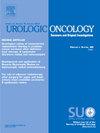预防性切口负压创面治疗对开放性根治性膀胱切除术后手术部位感染的影响。
IF 2.3
3区 医学
Q3 ONCOLOGY
Urologic Oncology-seminars and Original Investigations
Pub Date : 2025-08-11
DOI:10.1016/j.urolonc.2025.07.010
引用次数: 0
摘要
目的:开放性根治性膀胱切除术(ORC)后手术部位感染(SSI)很常见,发病率很高。切口负压伤口治疗(iNPWT)尚未在这一人群中进行严格的研究。在此,我们评估了预防性iNPWT与ORC患者术后伤口并发症之间的关系。材料和方法:我们查询了2000年至2023年间接受ORC的患者的机构前瞻性膀胱切除术登记,并通过接受预防性iNPWT对患者进行分层。主要终点是术后90天内SSI发生率。次要结局包括90天的伤口裂开、症状性血清肿,以及这3种伤口事件中的任何一种的复合终点。根据患者特征调整的多变量逻辑回归模型。结果:在2375例接受ORC的患者中,124例(5.2%)接受了预防性iNPWT。接受iNPWT的患者有较高的SSI危险因素发生率:中位BMI(31比28,P < 0.01)、糖尿病(28%比18%,P = 0.01)和回肠导管分流(86%比71%,P < 0.01)。在未经调整的分析中,iNPWT组和非iNPWT组的SSI发生率分别为6.5%和10.4%。在调整基线特征后,预防性iNPWT与SSI发生率显著降低相关(OR 0.47, 95%CI 0.22-0.99, P = 0.048)。在iNPWT的利用和次要结局之间没有观察到显著的关联。结论:预防性iNPWT治疗与ORC后SSI风险降低相关。虽然前瞻性和随机验证是必要的,但这些数据支持将这种低成本干预纳入高风险ORC患者的术后途径。本文章由计算机程序翻译,如有差异,请以英文原文为准。
The impact of prophylactic incisional negative pressure wound therapy on surgical site infection following open radical cystectomy
Purpose
Surgical site infection (SSI) following open radical cystectomy (ORC) is common and carries significant morbidity. Incisional negative pressure wound therapy (iNPWT) has not been rigorously studied in this population. Herein, we evaluate the association between prophylactic iNPWT and postoperative wound complications in ORC patients.
Materials and Methods
We queried our institutional, prospectively maintained cystectomy registry for patients who underwent ORC between 2000 and 2023, and stratified patients by receipt of prophylactic iNPWT. The primary outcome was SSI incidence within 90-days following surgery. Secondary outcomes included 90-day wound dehiscence, symptomatic seroma, and a composite endpoint of any of those 3 wound events. Multivariable logistic regression models adjusted for patient characteristics.
Results
Among 2,375 patients who underwent ORC, 124(5.2%) received prophylactic iNPWT. Patients who received iNPWT had higher rates of SSI risk factors: median BMI (31 vs. 28, P < 0.01), diabetes (28% vs. 18%, P = 0.01), and ileal conduit diversion (86% vs. 71%, P < 0.01). On unadjusted analyses, SSI incidence was 6.5% and 10.4% for the iNPWT and non-iNPWT cohorts, respectively. After adjusting for baseline characteristics, prophylactic iNPWT was associated with a significantly lower odds of SSI (OR 0.47, 95%CI 0.22–0.99, P = 0.048). No significant associations were observed between iNPWT utilization and secondary outcomes.
Conclusions
Prophylactic iNPWT therapy is associated with a reduced risk of SSI following ORC. While prospective and randomized corroboration is warranted, these data support the incorporation of this low-cost intervention into postoperative pathways for high-risk ORC patients.
求助全文
通过发布文献求助,成功后即可免费获取论文全文。
去求助
来源期刊
CiteScore
4.80
自引率
3.70%
发文量
297
审稿时长
7.6 weeks
期刊介绍:
Urologic Oncology: Seminars and Original Investigations is the official journal of the Society of Urologic Oncology. The journal publishes practical, timely, and relevant clinical and basic science research articles which address any aspect of urologic oncology. Each issue comprises original research, news and topics, survey articles providing short commentaries on other important articles in the urologic oncology literature, and reviews including an in-depth Seminar examining a specific clinical dilemma. The journal periodically publishes supplement issues devoted to areas of current interest to the urologic oncology community. Articles published are of interest to researchers and the clinicians involved in the practice of urologic oncology including urologists, oncologists, and radiologists.

 求助内容:
求助内容: 应助结果提醒方式:
应助结果提醒方式:


